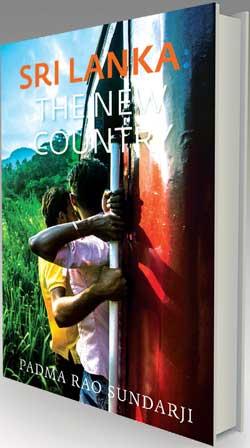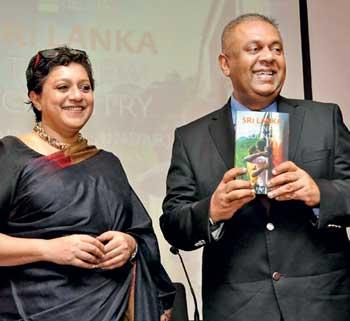Reply To:
Name - Reply Comment
 “I am neither an Indian Tamilian, nor do I have any Sinhalese relatives or genes... My primary language is English, German is my second best language. Hindi is the only Indian language I can speak, read, and write – fluently, I like to claim. I can produce smatterings of excruciatingly bad Tamil and passable Telugu and – enough French to save my life.”
“I am neither an Indian Tamilian, nor do I have any Sinhalese relatives or genes... My primary language is English, German is my second best language. Hindi is the only Indian language I can speak, read, and write – fluently, I like to claim. I can produce smatterings of excruciatingly bad Tamil and passable Telugu and – enough French to save my life.”
Am I Sri Lankan? I’d like to think, and say, I am. Certain fortuitous historical circumstances, however, prevent me from pasting that label on myself. To be Sri Lankan is to transcend if not repudiate an identity that my birth certificate conferred on me: Sinhalese and Buddhist. To be Sri Lankan is to endorse an identity-label which does not have historical antecedents, except perhaps in the minds of idealists, internationalists, and cosmopolitans. It is difficult for me – and this is one of many paradoxes confronting the inhabitants of this island – to reject that which I have been designated since birth, to accept something that downright denies the reality of that designation and identity. Being Sri Lankan is hence a matter for thought and speculation; we can hold endless discussions, and debates, over the meanings of words like Sinhalese, Buddhist, and Tamil, and go nowhere. Sri Lanka as a nation, a geographic entity and reality, however, endures. Of that there can be no doubt.
 Dr. Dayan Jayatilleka called it “smart patriotism”: the forging of an identity that balanced the geographic status as well as the national identity of Sri Lanka with the exigencies of race and religion; in other words, a Sri Lankan identity conscious of ethnicity and its historical roots. At a time of deep political polarisation post-2015, perhaps this did not make sense, but I often wonder whether it should have been disregarded altogether. If being a Sri Lankan should not mean trivialising ethnicity, belonging to an ethnic group should not mean trivialising a wider, broader nationality. After all, as scholars like R. A. L. H. Gunawardana have noted, identity in Sri Lanka was never really static. Perhaps the great Mervyn de Silva, Dr. Dayan’s father, put it best: “in this age of identity, ethnicity walks on water.” (He could have been writing of any country, from any period: all ages are those of identity, after all.) Yes it does, and Padma Rao Sundarji, who wrote an insightful book which I meant to review back in 2015, dwells on that theme admirably. This is an attempt at revisiting that book.
Dr. Dayan Jayatilleka called it “smart patriotism”: the forging of an identity that balanced the geographic status as well as the national identity of Sri Lanka with the exigencies of race and religion; in other words, a Sri Lankan identity conscious of ethnicity and its historical roots. At a time of deep political polarisation post-2015, perhaps this did not make sense, but I often wonder whether it should have been disregarded altogether. If being a Sri Lankan should not mean trivialising ethnicity, belonging to an ethnic group should not mean trivialising a wider, broader nationality. After all, as scholars like R. A. L. H. Gunawardana have noted, identity in Sri Lanka was never really static. Perhaps the great Mervyn de Silva, Dr. Dayan’s father, put it best: “in this age of identity, ethnicity walks on water.” (He could have been writing of any country, from any period: all ages are those of identity, after all.) Yes it does, and Padma Rao Sundarji, who wrote an insightful book which I meant to review back in 2015, dwells on that theme admirably. This is an attempt at revisiting that book.
Even the title of the book intrigues. It uses a definite article few commentators would have used on the country at the time: THE new country. For most analysts, post-2009 was in many ways a transformative period for Sri Lanka, politically, socially, economically. That alone, however, did not merit a definite article: it was always going to be just A new country. The certainty and assuredness with which she plunges into Sri Lanka and its road ahead, then, served to distance Padma Rao from the multitude of reporters, analysts, and observers who see the country as a failed state, even after the end of the war. In the preface itself she makes that point: “the book is aimed at affording readers interested in Sri Lanka an opportunity to hear the other side.” What is that “other side”? “Sri Lanka’s army generals, its president, its new chief minister of the Northern Province, and more importantly, ordinary Sinhalese and Tamil citizens rebuilding their lives.” A not so modest goal, although she herself downplays what she’s written: she calls it “a collection of stories.”
The best parts of Sri Lanka: The New Country emerge from conversations with the ordinary citizens and the army generals, and not the politicians and the governors. In this she explores, plays around with, and demolishes one dichotomy after another: Sinhalese versus Tamil, Buddhist versus Hindu, Sinhalese Buddhist versus Tamil Buddhist, Sinhalese Sinhala versus Sinhalese Tamil, generals versus ex-LTTE combatants, armies versus activists, and finally, at the end, Sri Lanka versus the rest of the world. In this she has the credentials: one of the first foreign journalists to face Prabhakaran at his press conference in 2002, the last journalist to interview Lakshman Kadirgamar (who, at the height of the peace process, warns her that all it will take for the war to recommence is one killing), and probably the first writer to interview Mahinda Rajapaksa before the 2013 provincial council election. She has another connection – her grandfather, who flew over here to manage the Paranthan Chemical Factory in 1956 – and in the end she revisits, or at least tries to revisit, that too.
Consequently, the conclusions she draws are not only fresh but also unbiased. For instance, she points out clearly that the Channel 4 documentarySri Lanka’s Killing Fields, despite the traction it got across the world, never substantiated its claim of 40,000 civilians killed by the army towards the end of the war: “it surprised me that the allegations by a solitary television channel were unquestioningly picked up and reproduced.” And it’s not only a question of numbers alone: as the author quite freely admits, most reporters who run into and write up the same conclusions about the country do so “from the veranda of the hotel in balmy Colombo.” The Sri Lanka that emerges from such reports, naturally, are both colourful and colourless: they reduce the island to a bloody teardrop (the teardrop association, incidentally, exasperates her: it simplifies an otherwise complicated country and terrain) with the same old, overused, hackneyed, over-hyped dichotomy, Sinhala versus Tamil, Buddhist versus Hindu; as Janaka Perera put it in a reply to an article by Robert Kaplan in The Atlantic (“Buddha’s Savage Peace”), violence in Sri Lanka was never linked to a religious crisis, since there was always much syncretism between Buddhism and Hinduism.
The latter, interestingly enough, may well be the most reproduced cliché about Sri Lanka and its war in foreign publications. Part of the blame for how it has been reproduced abroad must, I think, be shared by local activists and academics who see in the civil war a polarisation between one religion and another. In this Sinhala and Tamil nationalists are to blame, since a proper reading of history, particularly the history of group identity formation in Sri Lanka, would dispel the myth that Sinhalas and Tamils have been fighting each other since the dawn of time. The fact that no less a figure than Nissanka Malla, who in the 13th century decreed that only Sinhalas and Buddhists could rule the island, was not purely Sinhala himself, should compel reporters to rethink some of their notions of the country; to give just one example, the LTTE was never a Hindu movement which tried to combat a Buddhist hegemony, but an organisation made up of different strands of Jaffna society which had to counter the tide of Hindu caste-ism and found greater favour with sections of the Church than the Kovil. No foreign reporter has so far, to my knowledge, analysed this in-depth.
The best parts of Sri Lanka: The New Country emerge from conversations with the ordinary citizens and the army generals, and not the politicians and the governors
 Given the prevalence of such barely concealed simplifications and falsifications then, is it any wonder that we still come across lies propagated by media reports in many globally renowned publications? Such falsifications are not the preserve of foreigners only, since publications have local correspondents based in “balmy Colombo” who still, regardless of locality, cave in to the exigencies of Western editors. That is why Padma Rao, who wilfully describes herself as an “outsider” at several points in her book, tries to keep up a narrative that neither plays to the gallery nor subsumes the Sri Lankan experience within her own narrow encounters. She is not always successful – I did come across misprints (she writes that the JVP, not the JHU, is Mahinda Rajapaksa’s Sinhala Buddhist chauvinist coalition partner) – but apart from these minor errors, her narrative sustains our interest and evokes our sympathy.
Given the prevalence of such barely concealed simplifications and falsifications then, is it any wonder that we still come across lies propagated by media reports in many globally renowned publications? Such falsifications are not the preserve of foreigners only, since publications have local correspondents based in “balmy Colombo” who still, regardless of locality, cave in to the exigencies of Western editors. That is why Padma Rao, who wilfully describes herself as an “outsider” at several points in her book, tries to keep up a narrative that neither plays to the gallery nor subsumes the Sri Lankan experience within her own narrow encounters. She is not always successful – I did come across misprints (she writes that the JVP, not the JHU, is Mahinda Rajapaksa’s Sinhala Buddhist chauvinist coalition partner) – but apart from these minor errors, her narrative sustains our interest and evokes our sympathy.
What keeps her book alive is her interest in reconciling, rather than differentiating between, the many polarities which have been magnified and telescoped in Sri Lanka. Given its size (a bare 1/118th that of Australia), it comes to little or no surprise that an ethnic crisis should turn into an ethnic conflict within the space of a few years and decades. But perhaps the biggest factor which helped turn that crisis into a conflict was the number of mis-comparisons made by foreign writers and observers. Not even John Pilger, that most prolific of commentators who’s exposed the underside of Western corporate media, can desist from comparing the Sri Lankan war to the occupation of Palestine by Israel, forgetting that while Israel and Palestine both have sizeable populations in the region and elsewhere, in Sri Lanka the ethnic majority, the Sinhalese, happen to be a global minority, while the “occupied” minority, the Tamil, are a global majority: a point made by Dayan Jayatilleka in Long War, Cold Peace.
At present, then, what we need is a book that brings together, not keeps apart, differences. As of now, Padma Rao’s book fulfils that task beautifully. It is richly detailed, lucid, and not a little evocative: written from the head, as well as the heart.